Assessment of the Hydrological Performance of Grass Swales for Urban Stormwater Management: A Bibliometric Review from 2000 to 2023
Abstract
1. Introduction
2. Materials and Methods
2.1. Literature Search
2.2. Data Processing
3. Results and Discussions
3.1. Hot Topics
3.1.1. Analysis of Publishing Trends
3.1.2. Author and Country Analysis
3.2. Study on the Water Quality Purification Performance of Grass Swales
3.2.1. Current Research Status
3.2.2. Future Research Directions
3.3. Regulating Runoff
3.3.1. Current Research Status
3.3.2. Experimental Simulation
3.3.3. Future Research Directions
4. Conclusions
Author Contributions
Funding
Data Availability Statement
Conflicts of Interest
References
- Yao, Y.; Zhang, S.; Shi, Y.; Xu, M.; Zhang, J.; Zhang, Y.; Zhao, J. Landscape Pattern Change of Impervious Surfaces and Its Driving Forces in Shanghai during 1965–2010. Water 2021, 13, 1956. [Google Scholar] [CrossRef]
- Nagy, R.C.; Lockaby, B.G.; Kalin, L.; Anderson, C. Effects of Urbanization on Stream Hydrology and Water Quality: The Florida Gulf Coast. Hydrol. Process. 2012, 26, 2019–2030. [Google Scholar] [CrossRef]
- Gobel, P.; Dierkes, C.; Coldewey, W.G. Storm Water Runoff Concentration Matrix for Urban Areas. J. Contam. Hydrol. 2007, 91, 26–42. [Google Scholar] [CrossRef]
- Zheng, Q.; Qu, S.; Li, J.; Wang, W.; Zhang, Z. The Overlying Influence of Underground Structure and Impermeable Surface of the Ground on Groundwater Recharge in Residential Area Construction. In Proceedings of the 2017 6th International Conference on Energy, Environment and Sustainable Development (ICEESD 2017), Zhuhai, China, 11–12 March 2017; Atlantis Press: Paris, France, 2017; Volume 129, pp. 248–252. [Google Scholar]
- Xu, J.; Wu, X.; Ge, X.; Tian, Y.; Ma, X.; Li, Y.; Xu, X.; Li, Z. Variations of Concentration Characteristics of Rainfall Runoff Pollutants in Typical Urban Living Areas. Bull. Environ. Contam. Toxicol. 2021, 106, 608–613. [Google Scholar] [CrossRef] [PubMed]
- Zhang, W.; Li, S.; Tang, F. Characterization of Urban Runoff Pollution between Dissolved and Particulate Phases. Sci. World J. 2013, 964737. [Google Scholar] [CrossRef]
- Lee, J.Y.; Kim, H.; Kim, Y.; Han, M.Y. Characteristics of the Event Mean Concentration (EMC) from Rainfall Runoff on an Urban Highway. Environ. Pollut. 2011, 159, 884–888. [Google Scholar] [CrossRef]
- Zhou, Q. A Review of Sustainable Urban Drainage Systems Considering the Climate Change and Urbanization Impacts. Water 2014, 6, 976–992. [Google Scholar] [CrossRef]
- Raimondi, A.; Di Chiano, M.G.; Marchioni, M.; Sanfilippo, U.; Becciu, G. Probabilistic Modeling of Sustainable Urban Drainage Systems. Urban Ecosyst. 2023, 26, 493–502. [Google Scholar] [CrossRef]
- Fassman, E. Stormwater BMP Treatment Performance Variability for Sediment and Heavy Metals. Sep. Purif. Technol. 2012, 84, 95–103. [Google Scholar] [CrossRef]
- Wang, C. Low Impact Development (LID) Approaches in Sustainable Stormwater Management. In Frontiers of Green Building, Materials and Civil Engineering III; Kao, J.C.M., Sung, W.P., Chen, R., Eds.; Trans Tech Publications Ltd.: Stafa-Zurich, Switzerland, 2013; Volume 368–370, pp. 297–301. [Google Scholar]
- Nehrke, S.M.; Roesner, L.A. Effects of Design Practice for Flood Control and Best Management Practices on the Flow-Frequency Curve. J. Water Resour. Plan. Manag. 2004, 130, 131–139. [Google Scholar] [CrossRef]
- DeiGrosso, Z.L.; Hodges, C.C.; Dymond, R.L. Identifying Key Factors for Implementation and Maintenance of Green Stormwater Infrastructure. J. Sustain. Water Built Environ. 2019, 5, 05019002. [Google Scholar] [CrossRef]
- Wang, J.; Guo, Y. Dynamic Water Balance of Infiltration-Based Stormwater Best Management Practices. J. Hydrol. 2020, 589, 125174. [Google Scholar] [CrossRef]
- Malaviya, P.; Singh, A. Constructed Wetlands for Management of Urban Stormwater Runoff. Crit. Rev. Environ. Sci. Technol. 2012, 42, 2153–2214. [Google Scholar] [CrossRef]
- Eckart, K.; McPhee, Z.; Bolisetti, T. Performance and Implementation of Low Impact Development—A Review. Sci. Total Environ. 2017, 607, 413–432. [Google Scholar] [CrossRef]
- Wang, M.; Feng, S.; Ikram, R.M.A.; Chen, T.; Sun, C.; Chen, B.; Rao, Q.; Jin, H.; Li, J. Assessing the Performance and Challenges of Low-Impact Development under Climate Change: A Bibliometric Review. Sustainability 2023, 15, 13616. [Google Scholar] [CrossRef]
- Bernagros, J.T.; Pankani, D.; Struck, S.D.; Deerhake, M.E. Estimating Regionalized Planning Costs of Green Infrastructure and Low-Impact Development Stormwater Management Practices: Updates to the US Environmental Protection Agency’s National Stormwater Calculator. J. Sustain. Water Built Environ. 2021, 7, 04020021. [Google Scholar] [CrossRef]
- Zhang, Y.; Zhao, W.; Chen, X.; Jun, C.; Hao, J.; Tang, X.; Zhai, J. Assessment on the Effectiveness of Urban Stormwater Management. Water 2021, 13, 4. [Google Scholar] [CrossRef]
- Goulden, S.; Portman, M.E.; Carmon, N.; Alon-Mozes, T. From Conventional Drainage to Sustainable Stormwater Management: Beyond the Technical Challenges. J. Environ. Manag. 2018, 219, 37–45. [Google Scholar] [CrossRef] [PubMed]
- Andrés-Doménech, I.; Montanari, A.; Marco, J.B. Efficiency of Storm Detention Tanks for Urban Drainage Systems under Climate Variability. J. Water Resour. Plann. Manag. 2012, 138, 36–46. [Google Scholar] [CrossRef]
- Zhang, J.; Cao, X.-S.; Meng, X.-Z. Sustainable Urban Sewerage System and Its Application in China. Resour. Conserv. Recycl. 2007, 51, 284–293. [Google Scholar] [CrossRef]
- Ning, Y.-F.; Dong, W.-Y.; Lin, L.-S.; Zhang, Q. Current Research Trend on Urban Sewerage System in China. In Proceedings of the 2nd International Conference on Advances in Energy Resources and Environment Engineering, Rome, Italy, 18–20 July 2017; IoP Publishing Ltd.: Bristol, UK, 2017; Volume 59, p. 012048. [Google Scholar]
- Li, H.; Li, K.; Zhang, X. Performance Evaluation of Grassed Swales for Stormwater Pollution Control. In Proceedings of the 12th International Conference on Hydroinformatics (HIC 2016)—Smart Water for the Future, Incheon, Republic of Korea, 21–26 August 2016; Kim, J.H., Kim, H.S., Yoo, D.G., Jung, D., Song, C.G., Eds.; Elsevier Science BV: Amsterdam, The Netherlands, 2016; Volume 154, pp. 898–910. [Google Scholar]
- Li, J.; Gong, Y.; Li, X.; Yin, D.; Shi, H. Urban Stormwater Runoff Thermal Characteristics and Mitigation Effect of Low Impact Development Measures. J. Water Clim. Change 2019, 10, 53–62. [Google Scholar] [CrossRef]
- Zhou, S.; Diao, H.; Wang, J.; Jia, W.; Xu, H.; Xu, X.; Wang, M.; Sun, C.; Qiao, R.; Wu, Z. Multi-Stage Optimization Framework for Synergetic Grey-Green Infrastructure in Response to Long-Term Climate Variability Based on Shared Socio-Economic Pathways. Water Res. 2025, 274, 123091. [Google Scholar] [CrossRef]
- Jia, H.; Wang, X.; Ti, C.; Zhai, Y.; Field, R.; Tafuri, A.N.; Cai, H.; Yu, S.L. Field Monitoring of a LID-BMP Treatment Train System in China. Environ. Monit. Assess. 2015, 187, 373. [Google Scholar] [CrossRef]
- Steinke, K.; Stier, J.C.; Kussow, W.R.; Thompson, A. Prairie and Turf Buffer Strips for Controlling Runoff from Paved Surfaces. J. Environ. Qual. 2007, 36, 426–439. [Google Scholar] [CrossRef]
- Li, Y.; Huang, J.J.; Hu, M.; Yang, H.; Tanaka, K. Design of Low Impact Development in the Urban Context Considering Hydrological Performance and Life-Cycle Cost. J. Flood Risk Manag. 2020, 13, e12625. [Google Scholar] [CrossRef]
- Revitt, D.M.; Ellis, J.B.; Lundy, L. Assessing the Impact of Swales on Receiving Water Quality. Urban Water J. 2017, 14, 839–845. [Google Scholar] [CrossRef]
- Hunt, W.F.; Fassman-Beck, E.A.; Ekka, S.A.; Shaneyfelt, K.C.; Deletic, A. Designing Dry Swales for Stormwater Quality Improvement Using the Aberdeen Equation. J. Sustain. Water Built Environ. 2020, 6, 05019004. [Google Scholar] [CrossRef]
- Garcia-Serrana, M.; Gulliver, J.S.; Nieber, J.L. Non-Uniform Overland Flow-Infiltration Model for Roadside Swales. J. Hydrol. 2017, 552, 586–599. [Google Scholar] [CrossRef]
- Monrabal-Martinez, C.; Aberle, J.; Muthanna, T.M.; Orts-Zamorano, M. Hydrological Benefits of Filtering Swales for Metal Removal. Water Res. 2018, 145, 509–517. [Google Scholar] [CrossRef]
- Saracoglu, K.E.; Kazezyilmaz-Alhan, C.M. Determination of Grass Swale Hydrological Performance with Rainfall-Watershed-Swale Experimental Setup. J. Hydrol. Eng. 2023, 28, 04022043. [Google Scholar] [CrossRef]
- Rey-Mahía, C.; Sañudo-Fontaneda, L.A.; Andrés-Valeri, V.C.; Álvarez-Rabanal, F.P.; Coupe, S.J.; Roces-García, J. Evaluating the Thermal Performance of Wet Swales Housing Ground Source Heat Pump Elements through Laboratory Modelling. Sustainability 2019, 11, 3118. [Google Scholar] [CrossRef]
- Chen, T.; Wang, M.; Su, J.; Li, J. Unlocking the Positive Impact of Bio-Swales on Hydrology, Water Quality, and Biodiversity: A Bibliometric Review. Sustainability 2023, 15, 8141. [Google Scholar] [CrossRef]
- Gavric, S.; Leonhardt, G.; Marsalek, J.; Viklander, M. Processes Improving Urban Stormwater Quality in Grass Swales and Filter Strips: A Review of Research Findings. Sci. Total Environ. 2019, 669, 431–447. [Google Scholar] [CrossRef] [PubMed]
- Fin’ko, O.A. Modular Forms of Systems of K-Valued Functions of the Algebra of Logic. Autom. Remote Control 2005, 66, 1081–1100. [Google Scholar] [CrossRef]
- Chen, C. Visualizing and Exploring Scientific Literature with CiteSpace: An Introduction. In Proceedings of the 2018 Conference on Human Information Interaction & Retrieval (CHIIR’18), New Brunswick, NJ, USA, 11–15 March 2018; ACM Press: New Brunswick, NJ, USA, 2018; pp. 369–370. [Google Scholar]
- Egghe, L. Theory and Practise of the G-Index. Scientometrics 2006, 69, 131–152. [Google Scholar] [CrossRef]
- Sample, D.J.; Heaney, J.P. Integrated Management of Irrigation and Urban Storm-Water Infiltration. J. Water Resour. Plan. Manag. 2006, 132, 362–373. [Google Scholar] [CrossRef]
- Williams, E.; Wise, W. Hydrologic Impacts of Alternative Approaches to Storm Water Management and Land Development. J. Am. Water Resour. Assoc. 2006, 42, 443–455. [Google Scholar] [CrossRef]
- Lu, L.; Chan, F.K.S.; Johnson, M.; Zhu, F.; Xu, Y. The Development of Roadside Green Swales in the Chinese Sponge City Program: Challenges and Opportunities. Front. Eng. Manag. 2023, 10, 566–581. [Google Scholar] [CrossRef]
- Adib, M.; Wu, H.; Flohr, T. Professional Perceptions of Participatory Practices in Green Stormwater Infrastructure Development. PLoS Water 2023, 2, 84. [Google Scholar] [CrossRef]
- Lerma, N.R.; Barnett, M.J.; Goodall, J.L.; Heydarian, A. Improving Online Community Engagement Practices for Infrastructure Decision-Making: Experiences from Stormwater Infrastructure Management in Houston, Texas during the COVID-19 Pandemic. J. Infrastruct. Syst. 2024, 30, 2322. [Google Scholar] [CrossRef]
- Zhang, R.; Zhou, W.; Field, R.; Tafuri, A.; Yu, S.L.; Jin, K. Field Test of Best Management Practice Pollutant Removal Efficiencies in Shenzhen, China. Front. Environ. Sci. Eng. China 2009, 3, 354–363. [Google Scholar] [CrossRef]
- Rujner, H.; Leonhardt, G.; Marsalek, J.; Viklander, M. High-Resolution Modelling of the Grass Swale Response to Runoff Inflows with Mike SHE. J. Hydrol. 2018, 562, 411–422. [Google Scholar] [CrossRef]
- Gavric, S.; Leonhardt, G.; Osterlund, H.; Marsalek, J.; Viklander, M. Metal Enrichment of Soils in Three Urban Drainage Grass Swales Used for Seasonal Snow Storage. Sci. Total Environ. 2021, 760, 144136. [Google Scholar] [CrossRef]
- Rujner, H.; Leonhardt, G.; Marsalek, J.; Perttu, A.-M.; Viklander, M. The Effects of Initial Soil Moisture Conditions on Swale Flow Hydrographs. Hydrol. Process. 2018, 32, 644–654. [Google Scholar] [CrossRef]
- Brown, R.A.; Hunt, W.F. Improving Bioretention/Biofiltration Performance with Restorative Maintenance. Water Sci. Technol. 2012, 65, 361–367. [Google Scholar] [CrossRef]
- Gülbaz, S.; Kazezyılmaz-Alhan, C.M. Hydrological Model of LID with Rainfall-Watershed-Bioretention System. Water Resour. Manag. 2017, 31, 1931–1946. [Google Scholar] [CrossRef]
- Boyraz, U.; Kazezyılmaz-Alhan, C.M. An Investigation on the Effect of Geometric Shape of Streams on Stream/Ground Water Interactions and Ground Water Flow. Hydrol. Res. 2014, 45, 575–588. [Google Scholar] [CrossRef]
- Mantilla, I.; Flanagan, K.; Broekhuizen, I.; Muthanna, T.M.; Marsalek, J.; Viklander, M. Retrofit of Grass Swales with Outflow Controls for Enhancing Drainage Capacity. J. Hydrol. 2024, 639, 131637. [Google Scholar] [CrossRef]
- Zhang, W.; Zhang, X.; Shi, Z.; Zhang, D.; Li, S. Performance and Potential on TSS Removal of Grassed Swales in Simulated Rainfall Events. Desalin. Water Treat. 2018, 119, 160–165. [Google Scholar] [CrossRef]
- Dietz, M.E. Low Impact Development Practices: A Review of Current Research and Recommendations for Future Directions. Water Air Soil Pollut. 2007, 186, 351–363. [Google Scholar] [CrossRef]
- Wang, Y.; Yang, Y.; Liu, D.; Zhang, Z.; Ren, W.; Sun, Y.; Li, F. Local Insights into Industrial Nature-Based Solutions: A Comparative Study between Northwest China and New Zealand. CITIES 2024, 150, 105037. [Google Scholar] [CrossRef]
- Aulenbach, B.T.; Landers, M.N.; Musser, J.W.; Painter, J.A. Effects of Impervious Area and BMP Implementation and Design on Storm Runoff and Water Quality in Eight Small Watersheds. J. Am. Water Resour. Assoc. 2017, 53, 382–399. [Google Scholar] [CrossRef]
- Van Der Sterren, M.; Rahman, A.; Shrestha, S.; Barker, G.; Ryan, G. An Overview of On-Site Retention and Detention Policies for Urban Stormwater Management in the Greater Western Sydney Region in Australia. Water Int. 2009, 34, 362–372. [Google Scholar] [CrossRef]
- Kim, H.W.; Li, M.-H. Managing Stormwater for Urban Sustainability: An Evaluation of Local Comprehensive Plans in the Chesapeake Bay Watershed Region. J. Environ. Plan. Manag. 2017, 60, 1702–1725. [Google Scholar] [CrossRef]
- William, R.; Garg, J.; Stillwell, A.S. A Game Theory Analysis of Green Infrastructure Stormwater Management Policies. Water Resour. Res. 2017, 53, 8003–8019. [Google Scholar] [CrossRef]
- Sun, C.; Rao, Q.; Chen, B.; Liu, X.; Adnan Ikram, R.M.; Li, J.; Wang, M.; Zhang, D. Mechanisms and Applications of Nature-Based Solutions for Stormwater Control in the Context of Climate Change: A Review. Atmosphere 2024, 15, 403. [Google Scholar] [CrossRef]
- Yuan, D.; He, J.; Li, C.; Guo, X.; Xiong, Y.; Yan, C. Insights into the Pollutant-Removal Performance and DOM Characteristics of Stormwater Runoff during Grassy-Swales Treatment. Environ. Technol. 2019, 40, 441–450. [Google Scholar] [CrossRef]
- Bäckström, M. Grassed Swales for Stormwater Pollution Control during Rain and Snowmelt. Water Sci. Technol. 2003, 48, 123–132. [Google Scholar] [CrossRef]
- Stagge, J.H.; Davis, A.P.; Jamil, E.; Kim, H. Performance of Grass Swales for Improving Water Quality from Highway Runoff. Water Res. 2012, 46, 6731–6742. [Google Scholar] [CrossRef]
- Boger, A.R.; Ahiablame, L.; Mosase, E.; Beck, D. Effectiveness of Roadside Vegetated Filter Strips and Swales at Treating Roadway Runoff: A Tutorial Review. Environ. Sci.-Wat. Res. Technol. 2018, 4, 478–486. [Google Scholar] [CrossRef]
- Shafique, M.; Kim, R.; Kyung-Ho, K. Evaluating the Capability of Grass Swale for the Rainfall Runoff Reduction from an Urban Parking Lot, Seoul, Korea. Int. J. Environ. Res. Public Health 2018, 15, 537. [Google Scholar] [CrossRef] [PubMed]
- Leroy, M.C.; Marcotte, S.; Legras, M.; Moncond’huy, V.; Le Derf, F.; Portet-Koltalo, F. Influence of the Vegetative Cover on the Fate of Trace Metals in Retention Systems Simulating Roadside Infiltration Swales. Sci. Total Environ. 2017, 580, 482–490. [Google Scholar] [CrossRef]
- Ekka, S.A.; Rujner, H.; Leonhardt, G.; Blecken, G.-T.; Viklander, M.; Hunt, W.F. Next Generation Swale Design for Stormwater Runoff Treatment: A Comprehensive Approach. J. Environ. Manag. 2021, 279, 111756. [Google Scholar] [CrossRef] [PubMed]
- Zaqout, T.; Andradottir, H.O. Hydrologic Performance of Grass Swales in Cold Maritime Climates: Impacts of Frost, Rain-on-Snow and Snow Cover on Flow and Volume Reduction. J. Hydrol. 2021, 597, 126159. [Google Scholar] [CrossRef]
- Zhang, W.; Burgis, C.R.; Hayes, G.M.; Henderson, D.A.; Smith, J.A. Evaluation of Maintenance Efficiency for Multiple Green Infrastructure Designs Based on Water Quality Performance and Economic Costs. Ecol. Eng. 2024, 206, 107326. [Google Scholar] [CrossRef]
- Yu, S.L.; Kuo, J.T.; Fassman, E.A.; Pan, H. Field Test of Grassed-Swale Performance in Removing Runoff Pollution. J. Water Resour. Plan. Manag. 2001, 127, 168–171. [Google Scholar] [CrossRef]
- Yang, F.; Fu, D.; Zevenbergen, C.; Boogaard, F.C.; Singh, R.P. Time-Varying Characteristics of Saturated Hydraulic Conductivity in Grassed Swales Based on the Ensemble Kalman Filter Algorithm -A Case Study of Two Long-Running Swales in Netherlands. J. Environ. Manag. 2024, 351, 119760. [Google Scholar] [CrossRef]
- Brodie, I.M. SSUIS—A Research Model for Predicting Suspended Solids Loads in Stormwater Runoff from Urban Impervious Surfaces. Water Sci. Technol. 2012, 65, 2140–2147. [Google Scholar] [CrossRef]
- Lin, S.-H.; Zhao, X.; Wu, J.; Liang, F.; Li, J.-H.; Lai, R.-J.; Hsieh, J.-C.; Tzeng, G.-H. An Evaluation Framework for Developing Green Infrastructure by Using a New Hybrid Multiple Attribute Decision-Making Model for Promoting Environmental Sustainability. Socio-Econ. Plan. Sci. 2021, 75, 100909. [Google Scholar] [CrossRef]
- Ciou, S.-K.; Kuo, J.-T.; Hsieh, P.-H.; Yu, G.-H. Optimization Model for BMP Placement in a Reservoir Watershed. J. Irrig. Drain. Eng. 2012, 138, 736–747. [Google Scholar] [CrossRef]
- Wang, M.; Zhang, D.; Lou, S.; Hou, Q.; Liu, Y.; Cheng, Y.; Qi, J.; Tan, S.K. Assessing Hydrological Effects of Bioretention Cells for Urban Stormwater Runoff in Response to Climatic Changes. Water 2019, 11, 997. [Google Scholar] [CrossRef]
- Ding, L.; Ren, X.; Gu, R.; Che, Y. Implementation of the “Sponge City” Development Plan in China: An Evaluation of Public Willingness to Pay for the Life-Cycle Maintenance of Its Facilities. CITIES 2019, 93, 13–30. [Google Scholar] [CrossRef]
- Lees, C.; de Baets, S.; Rickson, J.; Simmons, R.W. Selecting Plant Traits for Soil Erosion Control in Grassed Waterways under a Changing Climate: A Growth Room Study. Eur. J. Soil Sci. 2021, 72, 2381–2397. [Google Scholar] [CrossRef]
- Forgione, E.R.; Felton, G.K.; Aydilek, A.H.; Davis, A.P. Hydrologic Performance of Vegetated Compost Blankets for Highway Stormwater Management. J. Sustain. Water Built Environ. 2024, 10, 537. [Google Scholar] [CrossRef]
- Ghadim, H.B.; Hin, L.S. Simulation of Rainfall-Runoff Response in Ecological Swale with On-Line Subsurface Detention Using Infoworks SD. Water Environ. Res. 2017, 89, 862–870. [Google Scholar] [CrossRef]
- Mustaffa, N.; Ahmad, N.A.; Razi, M. Variations of Roughness Coefficients with Flow Depth of Grassed Swale. In Proceedings of the Soft Soil Engineering International Conference 2015 (SEIC2015), Langkawi, Malaysia, 27–29 October 2015; IoP Publishing Ltd.: Bristol, UK, 2015; Volume 136, p. 012082. [Google Scholar]
- Van Der Heijden, M.G.A.; Bardgett, R.D.; Van Straalen, N.M. The Unseen Majority: Soil Microbes as Drivers of Plant Diversity and Productivity in Terrestrial Ecosystems. Ecol. Lett. 2008, 11, 296–310. [Google Scholar] [CrossRef]
- Augé, R.M. Water Relations, Drought and Vesicular-Arbuscular Mycorrhizal Symbiosis. Mycorrhiza 2001, 11, 3–42. [Google Scholar] [CrossRef]
- Su, J.; Wang, M.; Zhang, D.; Sun, C.; Zhao, X.; Razi, M.A.B.M. A Systematic and Bibliometric Review of Bioretention System (BRS) for Urban Services. Urban Clim. 2024, 55, 101923. [Google Scholar] [CrossRef]
- Kirby, J.T.; Durrans, S.R.; Pitt, R.; Johnson, P.D. Hydraulic Resistance in Grass Swales Designed for Small Flow Conveyance. J. Hydraul. Eng. 2005, 131, 65–68. [Google Scholar] [CrossRef]
- Gao, J.; Pan, J.; Tang, R.; Guo, S.; Liu, Y. LID Facility Layout and Hydrologic Impact Simulation in an Expressway Service Area. Pol. J. Environ. Stud. 2019, 28, 4153–4162. [Google Scholar] [CrossRef]
- Abida, H.; Sabourin, J.F.; Ellouze, M. ANSWAPPS: Model for the Analysis of Grass Swale-Perforated Pipe Systems. J. Irrig. Drain Eng. 2007, 133, 211–221. [Google Scholar] [CrossRef]
- Xie, J.; Wu, C.; Li, H.; Chen, G. Study on Storm-Water Management of Grassed Swales and Permeable Pavement Based on SWMM. Water 2017, 9, 840. [Google Scholar] [CrossRef]
- Deletic, A.; Fletcher, T.D. Performance of Grass Filters Used for Stormwater Treatment—A Field and Modelling Study. J. Hydrol. 2006, 317, 261–275. [Google Scholar] [CrossRef]
- Winston, R.J.; Powell, J.T.; Hunt, W.F. Retrofitting a Grass Swale with Rock Check Dams: Hydrologic Impacts. Urban Water J. 2019, 16, 404–411. [Google Scholar] [CrossRef]
- Kim, D.; Song, S.-K. The Multifunctional Benefits of Green Infrastructure in Community Development: An Analytical Review Based on 447 Cases. Sustainability 2019, 11, 3917. [Google Scholar] [CrossRef]
- Petit-Boix, A.; Sevigne-Itoiz, E.; Avelina Rojas-Gutierrez, L.; Barbassa, A.P.; Josa, A.; Rieradevall, J.; Gabarrell, X. Environmental and Economic Assessment of a Pilot Stormwater Infiltration System for Flood Prevention in Brazil. Ecol. Eng. 2015, 84, 194–201. [Google Scholar] [CrossRef]
- Gao, C.; Liu, J.; Zhu, J.; Wang, Z. Review of Current Research on Urban Low-Impact Development Practices. Res. J. Chem. Environ. 2013, 17, 209–214. [Google Scholar]
- McClymont, K.; Fernandes Cunha, D.G.; Maidment, C.; Ashagre, B.; Vasconcelos, A.F.; de Macedo, M.B.; Nobrega dos Santos, M.F.; Gomes Junior, M.N.; Mendiondo, E.M.; Barbassa, A.P.; et al. Towards Urban Resilience through Sustainable Drainage Systems: A Multi-Objective Optimisation Problem. J. Environ. Manag. 2020, 275, 111173. [Google Scholar] [CrossRef]
- Wang, M.; Zhang, Y.; Zhang, D.; Zheng, Y.; Zhou, S.; Tan, S.K. A Bayesian Decision Model for Optimum Investment and Design of Low-Impact Development in Urban Stormwater Infrastructure and Management. Front. Environ. Sci. 2021, 9, 713831. [Google Scholar] [CrossRef]
- Sun, C.; Rao, Q.; Xiong, Z.; Liu, M.; Liu, Y.; Fan, C.; Li, J.; Tan, S.K.; Wang, M.; Zhang, D. Optimized Resilience Coupled with Cost-Effectiveness for Grey and Green Infrastructure: A Case Study in a Historical and Cultural Area, Guangzhou, China. Ecol. Indic. 2024, 167, 112684. [Google Scholar] [CrossRef]
- Imteaz, M.A.; Ahsan, A.; Rahman, A.; Mekanik, F. Modelling Stormwater Treatment Systems Using MUSIC: Accuracy. Resour. Conserv. Recycl. 2013, 71, 15–21. [Google Scholar] [CrossRef]
- Chen, C.-F.; Sheng, M.-Y.; Chang, C.-L.; Kang, S.-F.; Lin, J.-Y. Application of the SUSTAIN Model to a Watershed-Scale Case for Water Quality Management. Water 2014, 6, 3575–3589. [Google Scholar] [CrossRef]
- Perales-Momparler, S.; Hernandez-Crespo, C.; Valles-Moran, F.; Martin, M.; Andres-Domenech, I.; Andreu Alvarez, J.; Jefferies, C. SuDS Efficiency during the Start-Up Period under Mediterranean Climatic Conditions. Clean-Soil Air Water 2014, 42, 178–186. [Google Scholar] [CrossRef]
- Sanudo-Fontaneda, L.A.; Roces-Garcia, J.; Coupe, S.J.; Barrios-Crespo, E.; Rey-Mahia, C.; Alvarez-Rabanal, F.P.; Lashford, C. Descriptive Analysis of the Performance of a Vegetated Swale through Long-Term Hydrological Monitoring: A Case Study from Coventry, UK. Water 2020, 12, 2781. [Google Scholar] [CrossRef]
- Li, F.; Chen, J.; Engel, B.A.; Liu, Y.; Wang, S.; Sun, H. Assessing the Effectiveness and Cost Efficiency of Green Infrastructure Practices on Surface Runoff Reduction at an Urban Watershed in China. Water 2020, 13, 24. [Google Scholar] [CrossRef]
- Byrne, D.M.; Grabowski, M.K.; Benitez, A.C.B.; Schmidt, A.R.; Guest, J.S. Evaluation of Life Cycle Assessment (LCA) for Roadway Drainage Systems. Environ. Sci. Technol. 2017, 51, 9261–9270. [Google Scholar] [CrossRef]
- Liao, Z.; Chen, H.; Huang, F.; Li, H. Cost–Effectiveness Analysis on LID Measures of a Highly Urbanized Area. Desalination Water Treat. 2015, 56, 2817–2823. [Google Scholar] [CrossRef]


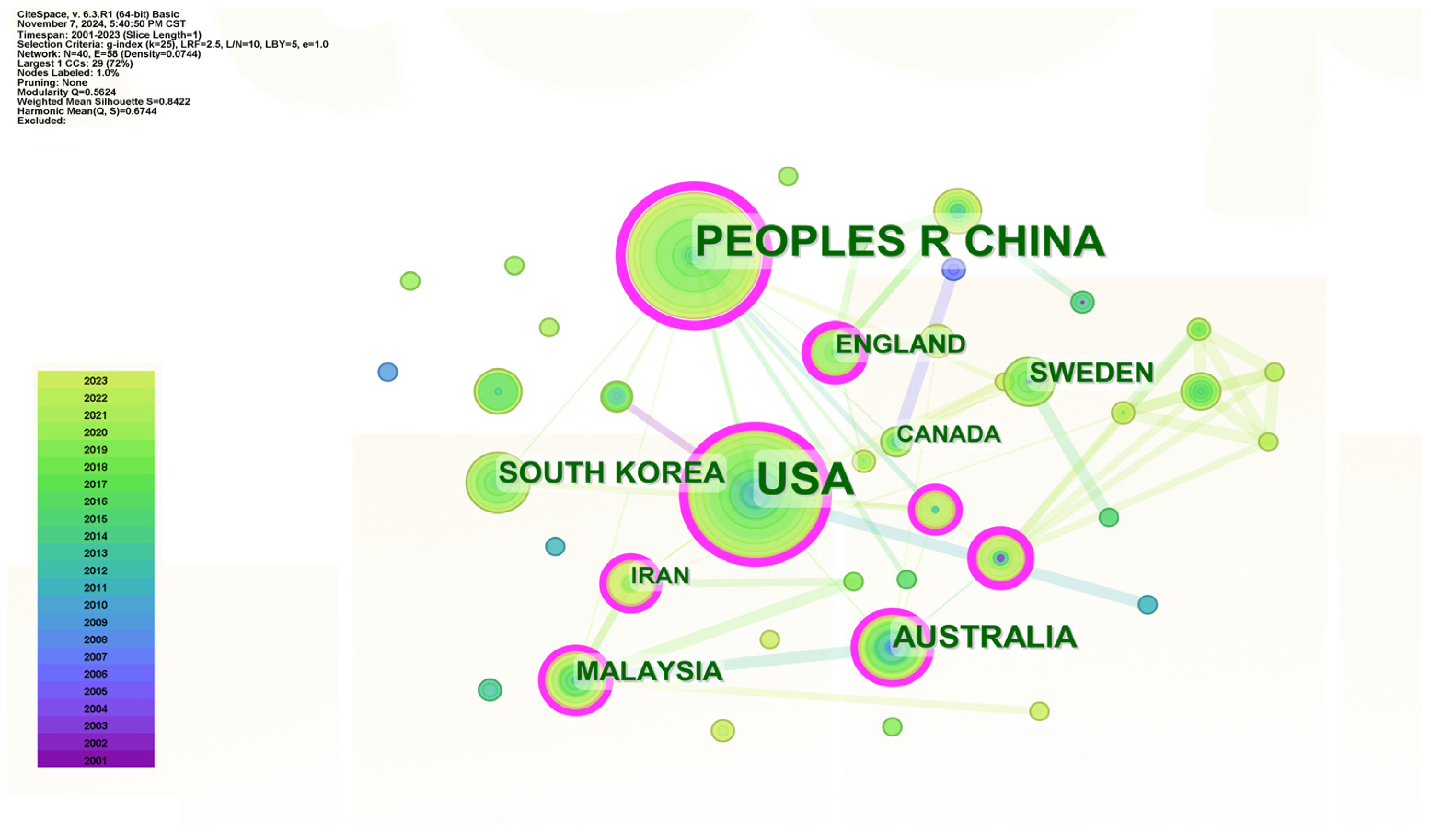
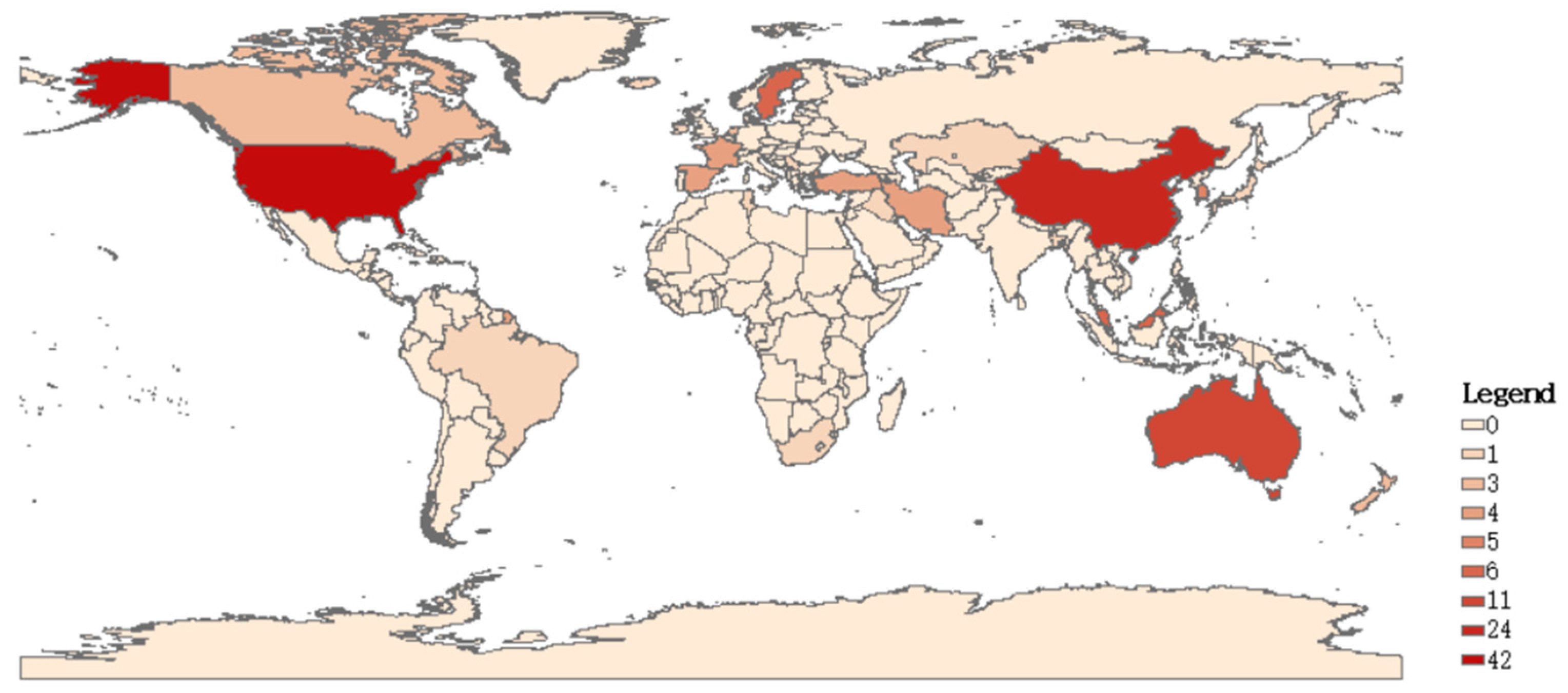
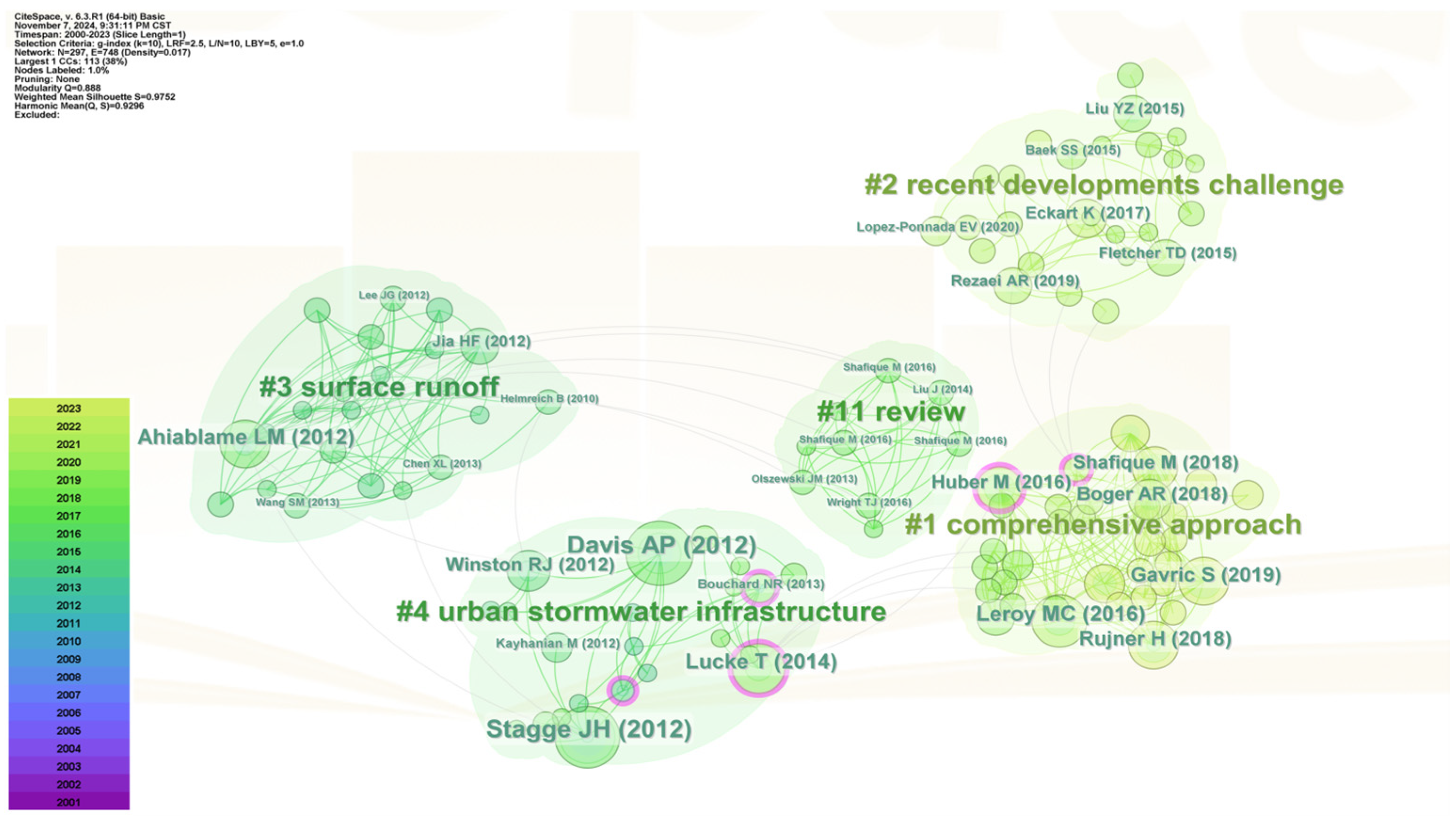

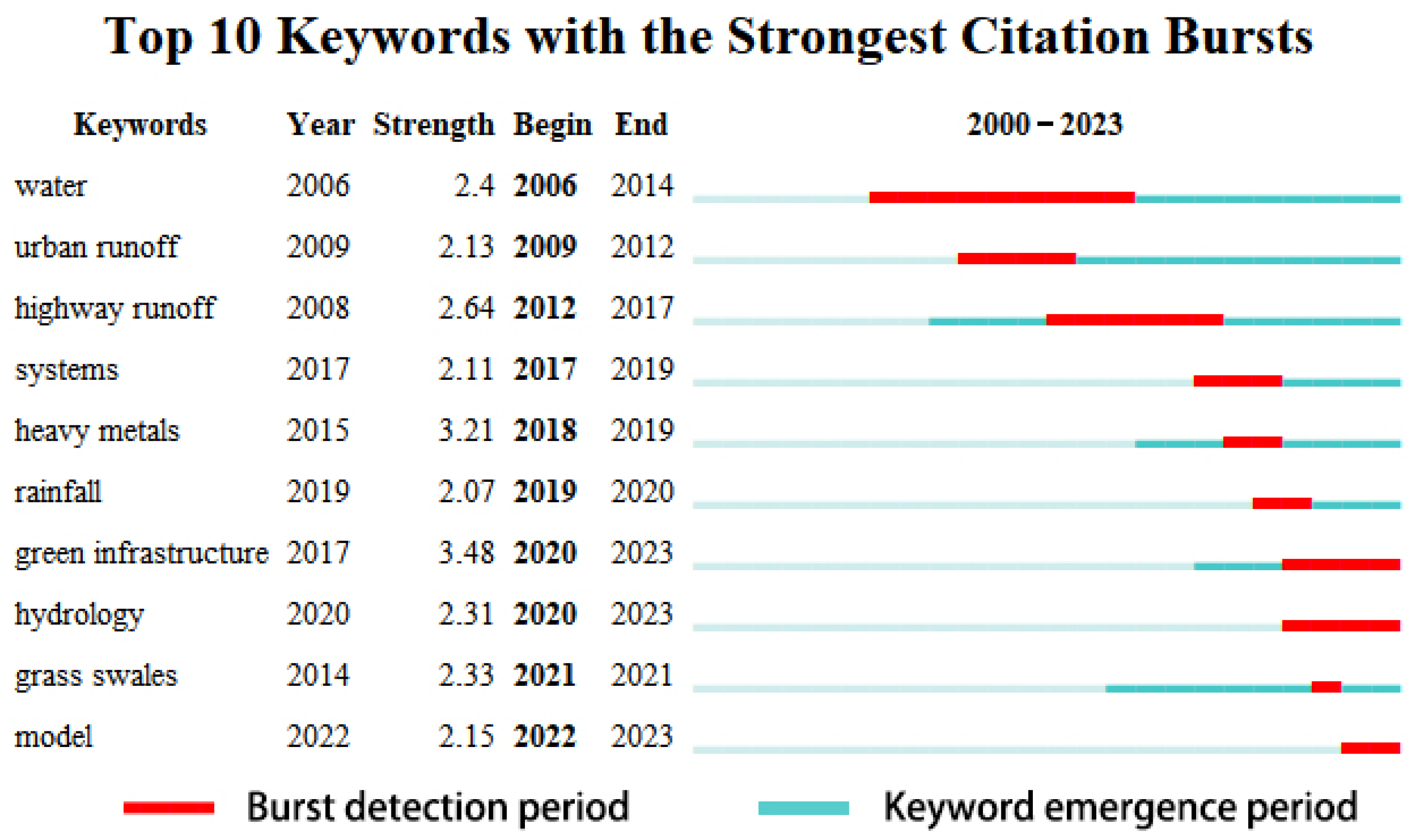
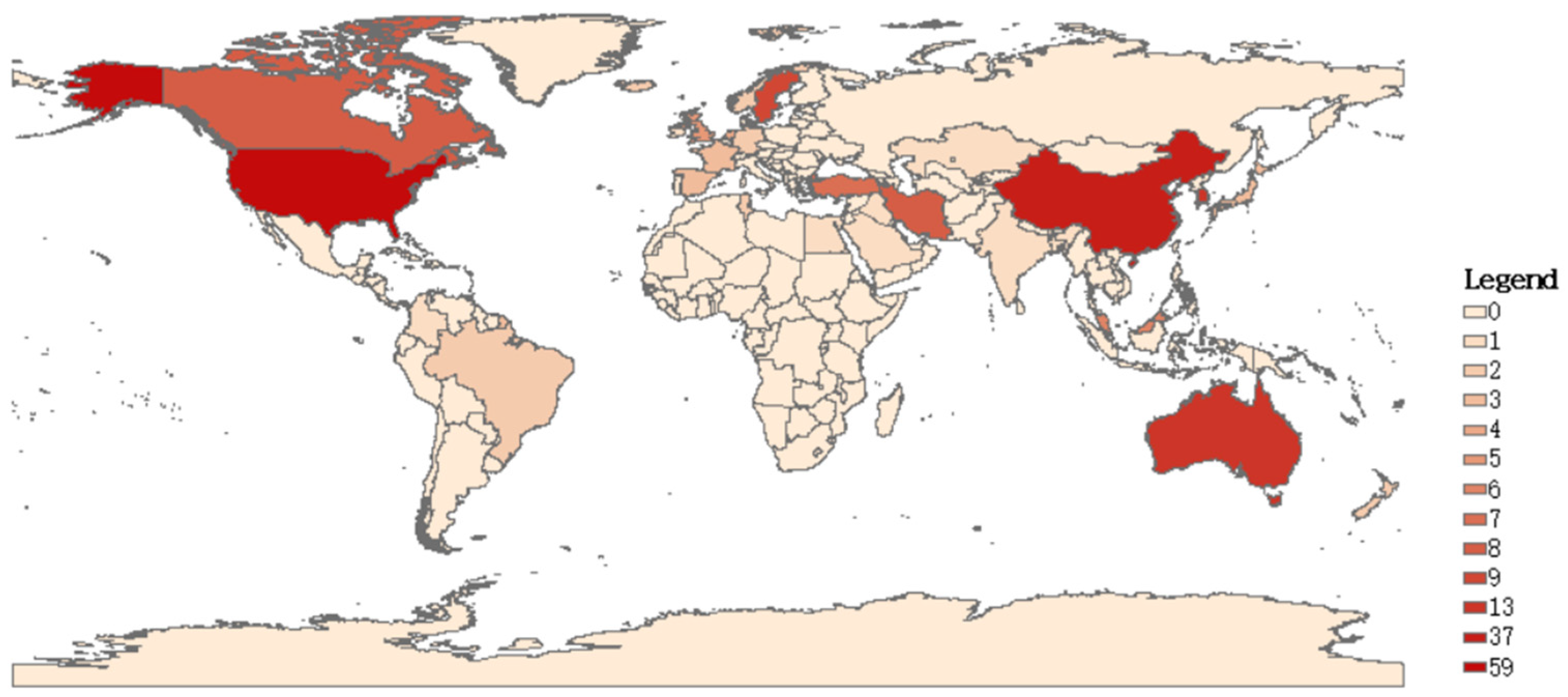
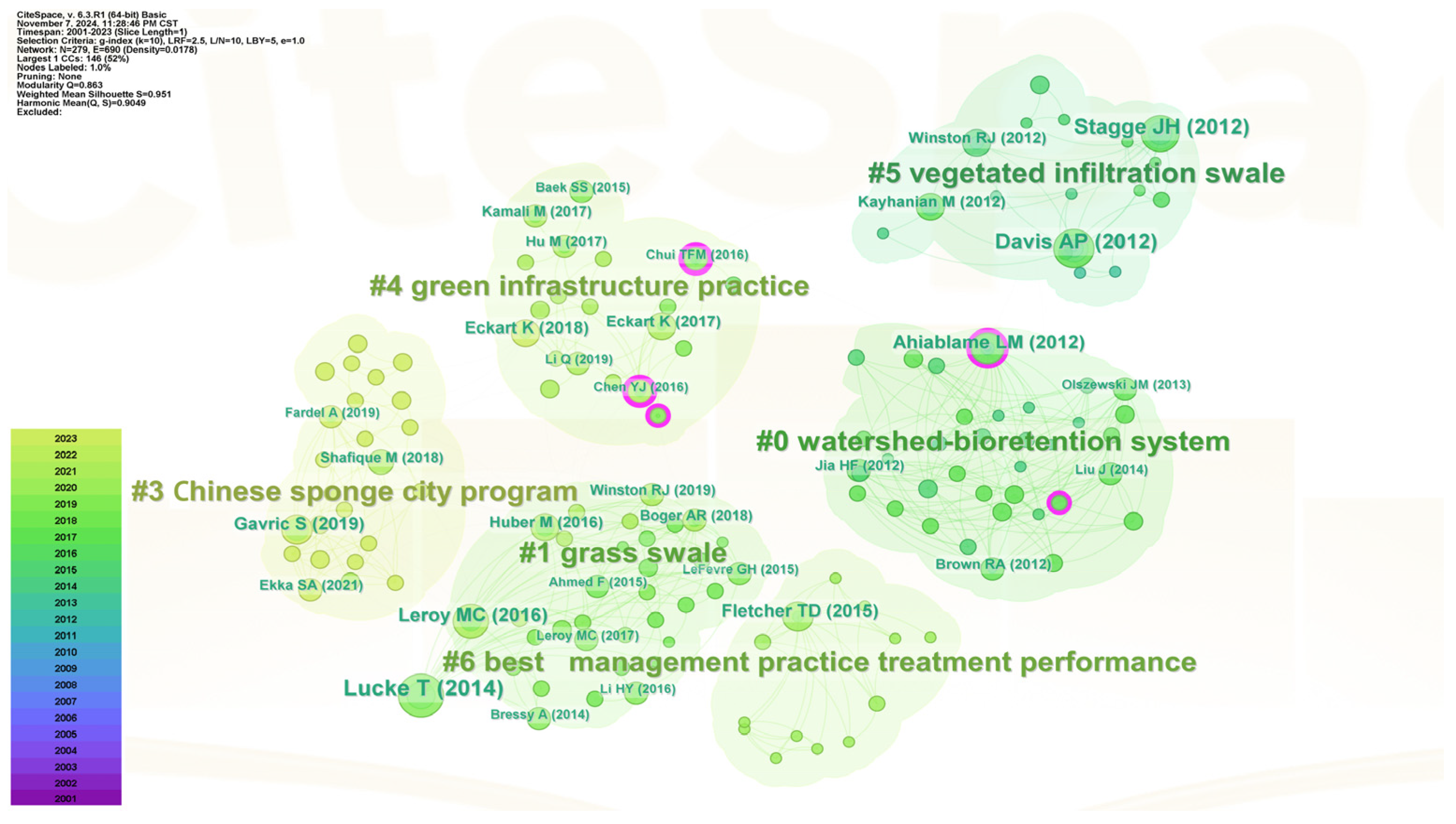

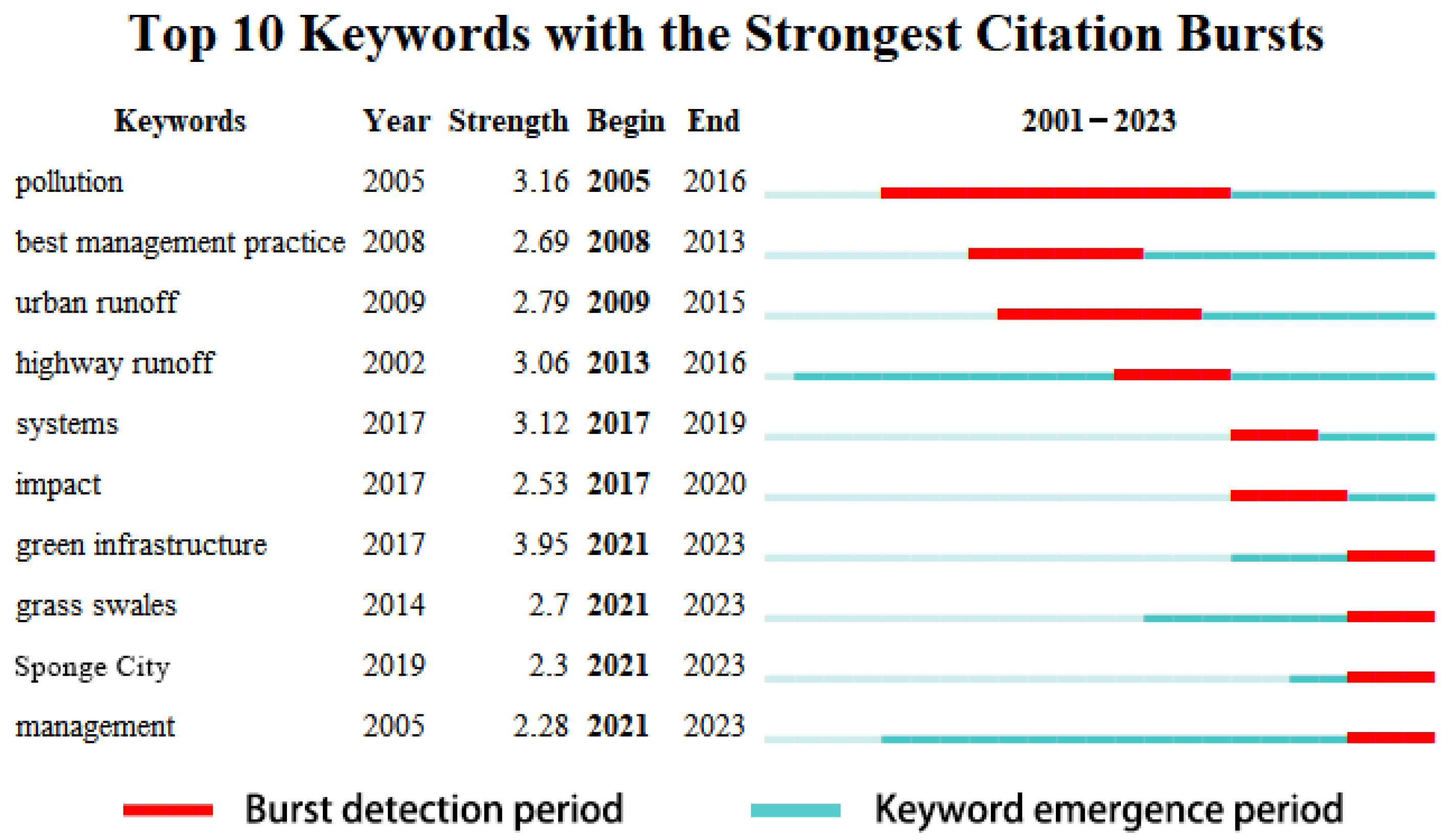
| Author | Country | Research Center | Publication Number | The Year the Paper Was First Published |
|---|---|---|---|---|
| Viklander, Maria | Sweden | Swedish Meteorological and Hydrological Institute | 7 | 2018 |
| Hunt, William Frederick | USA | North Carolina State University | 5 | 2012 |
| Gulbaz, Sezar | Iran | Istanbul University | 5 | 2014 |
| Kazezyilmaz-Alhan, Cevza Melek | Iran | Cerrahpasa Istanbul University | 5 | 2014 |
| Marsalek, Jiri | Sweden | Lulea University of Technology | 5 | 2018 |
| Deletic, Ana | Australia | Cooperative Research Centre for Water Sensitive Cities | 4 | 2001 |
| Leonhardt, Gunther | Sweden | Lulea University of Technology | 4 | 2018 |
| Field, Richard | USA | University of Nottingham | 3 | 2009 |
| Gavric, Snezana | Iran | Lulea University of Technology | 3 | 2019 |
| Bell, Colin | USA | Colorado School of Mines | 3 | 2020 |
| Country | Publication Number | The Year the Paper Was First Published |
|---|---|---|
| USA | 70 | 2001 |
| China | 56 | 2005 |
| Australia | 17 | 2003 |
| South Korea | 14 | 2008 |
| Malaysia | 11 | 2011 |
| Sweden | 10 | 2002 |
| England | 9 | 2003 |
| Iran | 8 | 2019 |
| Canada | 7 | 2006 |
| Netherlands | 6 | 2003 |
Disclaimer/Publisher’s Note: The statements, opinions and data contained in all publications are solely those of the individual author(s) and contributor(s) and not of MDPI and/or the editor(s). MDPI and/or the editor(s) disclaim responsibility for any injury to people or property resulting from any ideas, methods, instructions or products referred to in the content. |
© 2025 by the authors. Licensee MDPI, Basel, Switzerland. This article is an open access article distributed under the terms and conditions of the Creative Commons Attribution (CC BY) license (https://creativecommons.org/licenses/by/4.0/).
Share and Cite
Wang, X.; Zhang, R.; Hu, Q.; Sun, C.; Ikram, R.M.A.; Wang, M.; Cheng, G. Assessment of the Hydrological Performance of Grass Swales for Urban Stormwater Management: A Bibliometric Review from 2000 to 2023. Water 2025, 17, 1425. https://doi.org/10.3390/w17101425
Wang X, Zhang R, Hu Q, Sun C, Ikram RMA, Wang M, Cheng G. Assessment of the Hydrological Performance of Grass Swales for Urban Stormwater Management: A Bibliometric Review from 2000 to 2023. Water. 2025; 17(10):1425. https://doi.org/10.3390/w17101425
Chicago/Turabian StyleWang, Xuefei, Run Zhang, Qi Hu, Chuanhao Sun, Rana Muhammad Adnan Ikram, Mo Wang, and Guo Cheng. 2025. "Assessment of the Hydrological Performance of Grass Swales for Urban Stormwater Management: A Bibliometric Review from 2000 to 2023" Water 17, no. 10: 1425. https://doi.org/10.3390/w17101425
APA StyleWang, X., Zhang, R., Hu, Q., Sun, C., Ikram, R. M. A., Wang, M., & Cheng, G. (2025). Assessment of the Hydrological Performance of Grass Swales for Urban Stormwater Management: A Bibliometric Review from 2000 to 2023. Water, 17(10), 1425. https://doi.org/10.3390/w17101425








